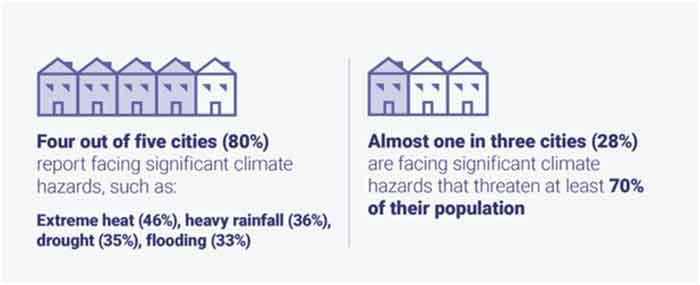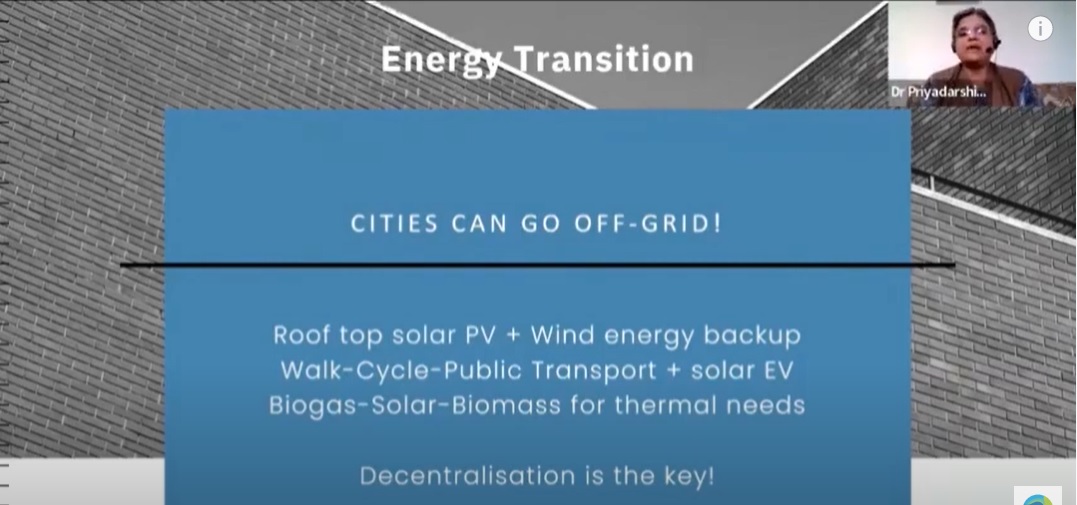Climate Change
Climate Change
The report highlighted how the sea level, in turn, has risen over the years. Thermal expansion explained 50% of sea-level rise between 1971 and 2018 and human activities were what most likely drove the increase since 1971. The average rate of sea level rise increased from 1.3 mm per year between 1901 and 1971, to 1.9 mm per year between 1971 and 2006. Between 2006 and 2018, this rose again to 3.7 mm per year. As per the WMO, the sea level rise has been 4.5 mm per year between 2013 and 2022. https://science.thewire.in/environment/sea-level-is-rising-and-will-continue-to-do-so-wmo-report/
According to the report, the threat from sea level rise is a “major economic, social and humanitarian challenge”. Several low lying small islands and countries that have huge coastal populations such as the Netherlands, Bangladesh, India and China would be most affected.
“Several big cities on all continents are threatened,” it read. The cities the report lists here includes Mumbai in India too. Others include Shanghai, Bangkok, London and New York. The Deccan Herald reported that Mumbai would be the most affected, with the sea level rise impacting 998 buildings and 24 km of road length in the city.
by AATHIRA PERINCHERY
15/02/2023
*Recarbonizing global soils - A technical manual of recommended management practices* FAO, 2021 the existing data on the impacts of the main soil management practices on SOC content in a wide array of environments, including the advantages, drawbacks, and constraints.
Volume 1: - Introduction and methodology http://www.fao.org/3/cb6386en/cb6386en.pdf
Volume 2: - Hot spots and bright spots of soil organic carbon http://www.fao.org/3/cb6378en/cb6378en.pdf hot spots of SOC as areas that represent a proportionally little of the global land surface but on which SOC storage is highly effective; bright spots as large land areas with low SOC stocks per km2 that represent a potential for further carbon sequestration.
Volume 3: Cropland, grassland, integrated systems and farming approaches - Practices overview. http://www.fao.org/3/cb6595en/cb6595en.pdf 49 practices that have a direct impact on SOC sequestration and maintenance in cropland, grassland, integrated systems and farming approaches.
Volume 4 - Cropland, grassland, integrated systems and farming approaches - Case studies. http://www.fao.org/3/cb6598en/cb6598en.pdf 51 case studies dealing with cropland, grassland, integrated systems and farming approaches.
Volume 5 - Forestry, wetlands, urban soils – Practices overview http://www.fao.org/3/cb6606en/cb6606en.pdf 24 practices that have a direct impact on SOC sequestration and maintenance in forestry, wetlands and urban soils.
Volume 6: - Forestry, wetlands, and urban soils – Case studies http://www.fao.org/3/cb6605en/cb6605en.pdf 30 case studies dealing with forestry, wetlands and urban soils management.
India’s Climate Action Pledges at Paris COP21 (NDC) and Glasgow COP26: What are these, how far have we come and what needs to improve?
https://www.cenfa.org/wp-content/uploads/2022/11/Indias-Climate-Action-Pledges-at-Paris-CoP-21-NDC-and-Glasgow-CoP26-What-are-these-how-far-have-we-come-and-what-needs-to-improve-A-briefing-paper.pdf By Soumya Dutta | November 1, 2022
India’s upper-middle and upper classes consume at much higher rates and contribute to emissions at nearly comparable global average rates https://scroll.in/article/984472/in-india-the-rich-cause-seven-times-more-emissions-than-the-poor .The mean carbon footprint of every Indian was estimated at 0.56 tonne per year – 0.19 tonne per capita among the poor and 1.32 tonne among the rich. To control the climate crisis at the national level, India thus needs to address inequalities, said the study. If economic growth does allow India’s middle classes to move into higher expenditure brackets, India can control the potential explosion in emissions by reworking its policies on food and energy use, it added.
SD write in an email - this does not include India's very recently released "Long Term Low Emission Development Strategy" LT-LEDS points
.

Climate hazards threaten nearly 70% of population of a third of world cities, finds a new report by the CDP, a London-based non-profit which runs the world’s environmental disclosure system for companies, cities, states and regions.
The analysis in Protecting People and the Planet, (https://www.cdp.net/en/research/global-reports/protecting-people-and-the-planet) released on October 13, 2022, is based on responses of 998 cities from across the globe to CDP-ICLEI Track in 2022, the world’s leading climate progress reporting platform for cities.
The report shows that cities taking at least one people-centered climate action, where the needs and experiences of people, especially vulnerable groups, are examined and considered from the assessment to implementation stages of action are realizing multiple additional benefits, on top of reducing emissions.
28/10/20022
 Role of Cities in Climate Action https://www.youtube.com/watch?v=ura2Xdf9xNI Panel Talk by Dr Priyadarshini Karve, National Convener, INECC, Visakhapatnam - Session 1 India’s Challenges and Opportunities in This Decade (held on 18th Feb, 2022
Role of Cities in Climate Action https://www.youtube.com/watch?v=ura2Xdf9xNI Panel Talk by Dr Priyadarshini Karve, National Convener, INECC, Visakhapatnam - Session 1 India’s Challenges and Opportunities in This Decade (held on 18th Feb, 2022
PIC Climate Conference 2022 on Decade of Change :
It is well-known that cities are a major contributors to climate change - about 75% of total global carbon emissions are from cities alone. To become a part of the solution ,city planning needs a new blueprint, with decentralisation, community participation and resilience built-into its foundations. For citizen involvement to be effective, communication strategies need to tailored as per the needs and capacities of citizens.
- five ‘disastrous’ climate tipping points
- Sustainable Mobility Initiatives as Climate Action
- South Asia's Floods Show Clear and Present Danger of Climate Change
- Scientists Petition EPA to Take Bold Steps
- India in the Climate Challenged World
- Communicating Climate: disservice to multiple efforts that have been underway to ensure there are fundamental transformations
- India to be worst hit if it cannot reduce fossil fuel dependency
- The need of the hour: A Renewables revolution?
- How PR is Preventing Awareness of Global Warming
- Climate Summit in US: A critical time for India in charting out its sustainable future
- World Drought Gets Worse, Cities Ration
- Why we need feminist leadership for climate justice
- The Scope of the Climate Crisis
- India Endures Record Heat Wave:
- Carbon Emissions Per Capita by Country
- The World Bank and IMF Are Getting It Wrong on Climate Change
- Why renewables can’t save the planet
- Climate Crisis: Scientists Hit the Streets
- India’s coal demand to increase 63% by 2023
- Debt, Climate, Justice
- The latest IPCC report explained
- Mumbai Climate Action Plan
- Climate Change & Cities. And Infrastructure
- As India’s petrochemical industry expands, experts question how it will achieve its net zero target
- Climate Change is a Market Failure
- Oil companies to help write rulebook on whether new fossil fuel drilling is green.
- why China and India aren’t the climate villains of COP26
- Careers to Solve the Climate Crisis
- $80-billion hole in India’s net zero pledge
- World will need 'carbon sucking' technology by 2030s
- Reframing incentives for climate policy action
- What another part of the Leaked 6th PICC report says.
- warning on climate tipping points in leaked draft IPCC report
- Why equity is key to stopping climate change
- Climate change to deliver debilitating blow to seven Karnataka districts
- Small Hydro Power Projects Are Seen As Green. In The Western Ghats, Local Communities Disagree
- The climate crisis explained in 10 charts
- TIME!
- Phasing Out Unabated Coal
- Global Climate Action: Where Do Indian Banks Stand?
- The ‘net-zero’ greenwash
- UN Climate Change Report Explained
- Climate Alliance—or Climate Conflict
- What Must Be Done to Avert Climate Catastrophe? New Economic Thinking
- Climate hazards are threatening vulnerable migrants
- European Commission proposes ambitious climate change policies
- Trump’s Moves to Dismantle Climate Action
